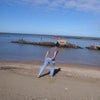The Convent of the Friars Minor Capuchin, popularly known as the Convent of the Capuchos (Portuguese: Convento dos Capuchos), but officially the Convento de Santa Cruz da Serra da Sintra (Convent of the Holy Cross of the Sintra Mountains), is a historical convent consisting of small quarters and public spaces located in the civil parish of São Pedro de Penaferrim, in the municipality of Sintra. Its creation was associated with the Portuguese Viceroy of India, D. João de Castro, and his family, but became a pious community of reclusive clergy that continued to occupy cramp humble spaces in the complex, until the religious orders were abolished in Portugal.
The convent was founded in 1560, consisting of eight monks that arrived from the Convent of Arrábida under the authority of D. Álvaro de Castro, counsellor of state and administrator for King Sebastian of Portugal. This sanctuary was established to the invocation of Santa Cruz (Holy Cross), and was originally the inspiration of Álvaro de Castro's father, the former fourth Viceroy of India, D. João de Castro (1500 - 1548). According to a legend, João de Castro was hunting in the mountains of Sintra, and chasing a deer, he found himself lost. Tired from his search, he fell asleep against a rock, and in a dream, he received a divine revelation to erect a Christian temple on the site.
In 1564, from an inscription found on site, indulgences were granted by Pope Pius IV, who offered requested that prayers be said for the Christian princes, the Church and the soul of deceased João de Castro.
Between 1578 and 1580, the Chapel of Santo António was constructed, along with the erection of a wall around the convent, under the orders of Cardinal Henry. The following year (around October) the convent was visited by King Phillip II of Spain, newly installed King of Portugal and Spain.
The primitive community of the convent was composed of eight friars, being the most famous of them Friar Honório, who, according to the book Mirror of Penitents, composed by one of the friars, lived to be 100 years old, despite having spent the last three decades of his life in penance, living inside a small hole inside the convent, which still exists today. In 1596, friar Honório, who lived in a grotto alongside the convent for 30 years, died. The story of Honório impressed later English Romantic poets, like Robert Southey and Lord Byron ("Deep in yon cave Honorius long did dwell/In hope to merit heaven, by making earth a hell.")
In the 17th century, a painting/panel of São Pascoal Bailão, by Vicente Carducho, was completed, while in 1610 several mural paintings on the exterior of the Chapel of Senhor Morto. In 1650 a marker was erected to identify the road to the convent.
In October 1654, King John IV of Portugal visited the convent, ordering the sheriff of Cascais should send the friars six dozen fish and dried meat, as well as all the fish necessary to support the festival of São Francisco. At the same time, D. Luísa de Gusmão provides the order a moio of wheat, and an arroba of cereals from annual harvests. By the second half of the 17th century, King Peter II of Portugal doubled the gift of D. Luísa de Gusmão. By 1684, the widow of Álvaro de Castro (the third patron of the convent), the lady Maria de Noronha was buried at the door of the convent (as was the tradition at the time). Similar royal patronage was conceded by King John V of Portugal in the 18th century, who offered a pipa of olive oil to the convent per year, as well as an azulejo tiles.
By 1728, the convent was described by friar António da Piedade as secluded "between dense fields, high boulders, and while trees, that in this refuge produces the mountains that are so many...". Similarly, the convent was still inhabited by members of the religious community in 1787.
Between 1830 and 1837, William Burnett completed a carving on the steps leading to the Chapel of Santo António, flanked by a low wall.
As a result of the extinction of the religious orders in Portugal, in 1834, the convent was acquired by the second Count of Penamacor, D. António de Saldanha Albuquerque e Castro Ribafria (1815-1864), descendant of João de Castro. It remained in the possession of this generation until 1873, when it was acquired by Sir Francis Cook, first Viscount of Monserrate.
In 1889, the convent was described as "situated in the centre of a sad solitude, encircled by a dryness and whipped by gales...this small monastery, open to the rocks and containing a dozen cells, in which can barely move the disgraceful inhabitants".
In the first half of the 20th century, the site was acquired by the State, although little was done until the middle of that century. It was bought by the Portuguese State in 1949. The DGEMN Direcção Geral dos Edifícios e Monumentos Nacionais (General Directorate of Buildings and National Monuments) began a series of public projects to preserve the site starting in the 1950s: in 1952, the construction of the roofing in the chapel, farmhouse and latrines; in 1954 and 1955, repairs to the water-pipes and guardhouse; in 1958, repair of the roofing; in 1961, repair of the farmhouse roof; in 1963, repair of the roofing and interiors; in 1967, the replacement of two doors covered in cork, ceilings, pipes and cleaning of the spaces. These projects continued with the Institute Florestal (Forestry Institute) and the Direcção-Geral das Florestas (General Directorate of Forests) which were responsible for conservation, cleaning and maintenance of the buildings and grounds in 1971, 1983-1985 and 1994.
During the 1920s, an image of Santa Maria Madalena still existed in a niche near the gate, but eventually collected by the state and stored in the Pena National Palace. Much later, images of Santo António and São Francisco, located in the retable in the church, and two candelabras were stolen from the site. For this reason, security and a degradation of the site, the property was closed to the public in 1998. Yet, in August 1998, the site was assaulted and robbed of several images and sculptures. These events and the continued degradation of the site resulted in the creation of the Associação dos Amigos do Convento dos Capuchos (Association of the Friends of the Convent of the Capuchos).
The Capuchos Convent became part of the Cultural Landscape of Sintra World Heritage Site, classified by UNESCO in 1995.
On 1 June 2001, the convent was re-opened to the public, after fears of its degradation, under the concession of the Parques de Sintra Monte da Lua S.A. Between 2000 and 2001, public works, conservation and restoration of many of the buildings.
In 2011, the film This Side of Resurrection, directed by Joaquim Sapinho, was shot inside the walls of the convent.
The minimalist convent was erected in perfect harmony with its surroundings, implanted in the rocks and boulders that formed this part of the Sintra Mountains. Due to the slopes, many of the dependencies are constructed on the slopes, each level used to identify the ascendency and purification of the spirit. The hall of retreat, which is further elevated then other spaces, is reached from a passage from thehall of penitence. The church is integrated into the complex, with little indications from the exterior. Researchers have suggest that the composition of buildings and spaces were influenced by the number 8 (evident in the number of cells and stairs between rooms), and which symbolized infinity. A comparable metaphor exists in the different roads/paths, which symbolized the dichotomy between good and bad roads to be taken in spiritual fulfillment. Poverty was the central notion which ruled the construction of the Convent of the Capuchos. The whole building is small. Its windows and doors are coated with cork, the traditional material of Portugal, the last being smaller than a man's height, to induce genuflection. Decoration is scarce and minimal. After visiting the convent in 1581, Philip I of Portugal said "Of all my kingdoms, there are two places I estimate especially, El Escorial for being so rich, and the Convent of the Holy Cross for being so poor".
The site is located in the rural part of Sintra, along the northeastern flank of the Sintra Mountains, approximately 325 metres above sea level, in a location marked by dense vegetation and accentuated slopes, near King Ferdinand II's hunting grounds (Tapada D. Fernando II). The convent, surrounded by a forest of oak and shrubbing species of trees, is walled into an area of rocks and exposed boulders. Along Sintra's old road connecting the village to Colares, and near the Palace of Monserrate, there is a road that heads towards this religious retreat, indicated by a 17th-century marker: "CAMINHO PARA O CONVENTO DE SANTA CRUZ DA SERRA, VULGO CAPUCHOS"; "1650". The access to the grounds is made by a portal (in the southeast corner of the site), or by the Terreiro das Cruzes (Terrace of Crosses), an irregularly-walled enclosure with a calvary located in the southwest corner and visitor's centre. To the left of the cross in the Terrace of Crosses, is the principal entrance or Pórtico das Fragas (Portico of the Rocks), with an access-way comprising two large boulders, one of which is surmounted by a bell-gable. From the walled enclosure, a small flight of stairs leads into the Terreiro do Campanário (Terrace of the Bellfry), a small irregular patio with cross, which leads to the buildings. The southeast entrance, located a further distance from the visitors centre, comprises a gate and ancillary building, which leads directly to the much larger Terreiro do Fonte (Terrace of the Fountain) with the religious site. So named because of the large octagonal water fountain, the Terrace is a principal square within the retreat, with bunk seating in rock around its edges. Legend suggests that King Sebastian would eat his meals around this fountain when he visited the convent. The fountain, itself, shows vestiges of 17th century azulejo tile.
The plan of the site is irregular, composed of various spaces at different slope heights, incorporated into the local rock and cliffs. The church, integrated into the complex, has a longitudinal plan, with a nave and presbytery into the rock. Its simple facades, with no decoration, are uncommonly utilitarian, with a lack of ostentation typical of the period of its construction. The principal entrance, across the southeastern portal to the elevated Terreiro da Fonte, is made from two steps. The stone patio has vestiges of two tombs, while the roof is covered in cork. In the centre wall, the cut backrests are decorated with pebbles and ceramic fragments, with an conch-like arched niche, decorated with ceramic fragments. On the wall fascia, accessed by stairs on two sides converging onto a level platform, there are two door frames covered with cork, to corresponding quarters of pilgrims. Between these, a large wooden cross, inscribed muraria box, framed with pebbles and shells, with traces of a painting depicting a crucified monk. The right-side wall is embossed with a representation of Virgin with the Childand the founder of the convent, D. Álvaro de Castro, topped by a triangular pediment, the tympanum with Christ Pantocrator. On the opposite wall, the lintel is surmounted by cross of rubble, flanked by two small openings, with access to the Chapel of Senhor dos Passos.
This chapel interior is covered in monochromatic azulejos (blue-on-white tiles), with a rounded niche on the main wall, with panels showing scenes from the Flagellation of Christ and Crowning with Thorns on opposite sides of the wall. On the vaulted ceiling there are also symbols from the Passion and stars. On the left wall, a relief of the Virgin with Child framed by a canopy held by angels. On the right wall, surmounted by a cross of shells over a skull and crossbones, is the old entranceway for novices (and represented the transition between the spiritual and terrestrial lives), leading from the Pátio do Tanque (Patio of the Tank) across a corridor with busts of friars minor. On the left wall, and surmounted by a cross of rubble, shells and fragments of ceramics, is an epigraphic inscription, and doorway to the church.
The church interior consists of a small nave, covered with a vaulted ceiling and paved with stone slabs. The walls show remnants of plaster with some exposure to the rock face. On the pulpit side there is a framed inscription, surmounted by a carved stone of the coat-of-arms of the Castro family (the patrons of the convent). The inscription reads:
D. ALVARO DE CASTRO DO CONS.º DE ESTADO, E VEDOR DA FAZ.ª DEL REY. D. SE / BASTIÃO FVNDOV ESTE CONVENTO POR MANDADO DO VISORY. D. IOAO / DE CASTRO SEV PAY ANNO 1560: O PADROADO HE DOS SVCESSORES DE SVA CASA. / O ALTAR DESTA IGRE.ª HE PRIVELIGIADO TODOS OS DIAS A QVAL QVER SACERDO / TE QVE NELLE CELEBRAR TODAS AS PESSOAS QVE CONTRITAS E CONFESSADAS / OV CÕ PROPOSITO DE SE CONFESSAR, VISITAREM ESTA IGR.ª NA FESTA DA INVE / AÕ. DA S. CRUZ DESDAS PRIMEIRAS VESPORAS ATE O SOL POSTO DO DIA E ROGA / REM A DEOS POLA PAZ ENTRE OS PRINCIPES CHRISTAÕS, EXTIRPAÇÃO DAS HERESIAS EXALTAÇÃO DA. S. MADRE IGR.ª E POLA ALMA DE. D. IOAÕ DE CASTRO GANHAÕ / INDVLG.ª PLEN.ª E REMISSÃO DE SEVS PECCADOS. ESTAS INDVLG.AS CÕCEDEO O PAPA PIO 4º ANNO DE 1564 A INSTÃCIA DO MESMO. D. ALVº DE CASTRO, SENDO EMBAIX.OR E ROMA
D. Álvaro de Castro of the Council of State, and Overseer of State of the King D. Sebastian founded this convent by order of the Viceroy D. João de Castro his father, Year 1560: the patron and his successors of his House. The altar of this Church is privileged everyday by any priest who in it celebrate all contrite and confessed people, or who proposed to confess, visited this church in the festival of...of the Holy Cross from the first vespers until sunset on the day and pray to God for peace between the Christian princes, extripication from the heresies exalted to the Sainted Mother Church e for the soul of D. João de Castero to gain indulgences and remission of his sins. This indulgences were conceded by Pope Pius IV in the year of 1564 by request of D. Álvaro de Castro, being Ambassador of Rome
The presbytery is marked by the vestiges of a wooden balustrade, and covered by the rocks that cover the space. The church walls include fascia inscribed on the rocks and a concave retable in marble, crowned by cornices. The central axis includes three panels: the central panel, includes the tabernacle framed by pilasters and flanked by two niches, and the lateral oblique panels, which also have a niche. The main altar, in polychromatic marble front, is designed with organic composition. On the pulpit side, there is a small staircase in rock, with access to the choir, itself covered in cork. The space is illuminated by two small windows, with two bunks of seating, also covered in cork, where the friars participated in masses.
The interior dependencies are aligned along several corridors within the complex, and broken by small steps formed by the slopes on which the convent was built. Many of the spaces are covered in cork, which acted as an insulator (protecting the clergy from the cold humid environment); many of the doors, windows are covered in cork, while the austere floor is composed of stone slabs. The personal quarters of the friars, eight in total, are small in size with small entrance-ways and access to the main corridor. Friar António da Piedade, writing in 1728, described the cells as so small that a few of the monks carved portions of the wall, in order to accommodate their feet. The refectory included a large slab that was ordered extracted from the mountains by Henry, King of Portugal and used as a table by the monks, and small cupboard. The relatively small space was connected to the kitchen, with stone and chimney, rock bunks for counters and spaces carved into the rock. The Casa das Águas (House of the Waters) accessible through an exterior corridor to a cistern and spring, was the collection and distribution space for water into the convent, and included a water tank, latrines and urinal. In addition, the complex included a space for the novice; an old library with roof covered in cork; an infirmary; hall of penitence; two cells covered in wood; a space for solitude/retreat (located at the highest point in the complex); and the circular Casa do Capítulo, whose access door and walls are decorated in cork, interrupted by a niche.
The Casa do Capítulo fronts the octagonal Patio do Tanque and the Chapel of Santo António (or Senhor do Horto), a rectangular single nave chapel covered in tiles with patio. This main porch oriented towards the fountain, is accessible by a staircase, and includes a painted mural with Saint Francis of Assisi and Saint Anthony. The interior is paved in tiles with remnants of wall murals towards the vaulted ceiling. The fascia, consisting of a false retable, includes a niche carved into the wall, moulded into an arch, over an altar covered in azulejo tile. The azulejos (monochromatic blue-on-white) include representations of two angels holdings scrolls, with a central inscription. The Chapel of Senhor Crucificado (or Chapel of the Ecce Homo), with rectangular plan is covered in tiles. Its interior is decorated with murals, with a friezes in monochromatic azulejos (blue-on-white) and elevated central niche on the wall.
In the most elevated zone of the complex is the grotto of Honório de Santa Maria, with an inscription along the path, stating "HIC. HONORIVS. / VITAM. FINIVIT. ET. IDEO. CVM DEO. / VITAM. REVIVIT / OBIIT ANNO / DE 1596".
The old vegetable gardens, located below the Pátio do Tanque, are accessed from this space or the main portal, while several tanks and water channels criss-cross the spaces from the convent.





